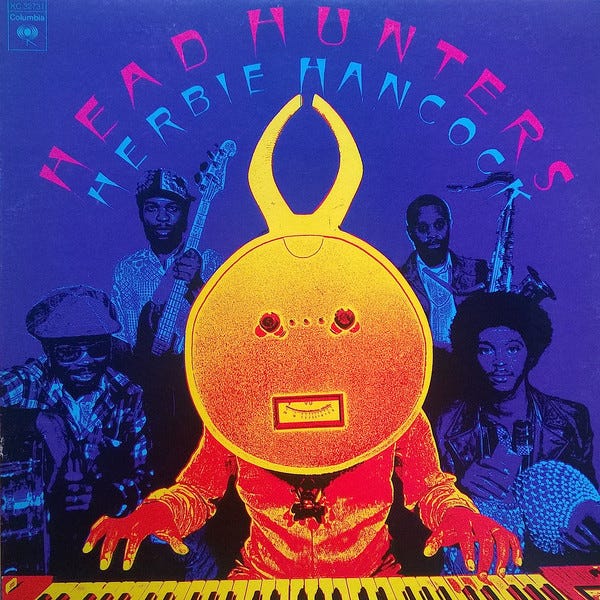Afro-Diasporic Imagery in Herbie Hancock’s Discography

In this post, I will be discussing the African imagery depicted on Herbie Hancock’s albums.
The 1970s was Herbie Hancock’s transition into more African based music.
He created a band called Mwandishi.
The word Mwandishi means “writer” in Swahili.
Crossings (1972)


This was Herbie’s second album with the Mwandishi band.
With an electronic/avant-garde jazz approach, Crossings was a musical dialogue with Africa. The album is a commentary on the Middle Passage through themes such as water, space, and slavery.
These themes are reminiscent of what would later be known as Afrofuturism.
Crossings shows spiritual elders crossing the waters, possibly the Altantic Ocean. Two of the men, one with grey hair the other with black hair have elongated heads, reminiscent of the Mangbetu tribe.
The Mwandishi band had an improvised playing style and the members were so intuitive with each other while playing solos. During a concert in Seattle in 1972 the band had a transformative experience that led Herbie into becoming a Buddhist.
Sextant (1973)

https://www.youtube.com/watch?v=6Mz5rR0y0fM
Sextant is jazz-fusion album. The album sounds like it could be an answer to space music genre. The electronic sound crashing into the improvised jazz gives it a cosmic and otherworldly feel, almost reminiscent of Sun Ra’s music, furthering into Afrofuturist themes over 30 years before the term was invented.
The album cover itself is based on a photograph taken in 1971 by George F. Mobley for National Geographic. The album art was painted by Robert Springett, displaying African and East Asian iconography such as pyramids, lotus flowers, Buddha, and an African elder.
The main cover image is of the Tutsi tribe (also known as the Watusi) located in Rwanda, Africa.
Here is a clip below of the Tutsi people in action taken from the 1985 movie adaptation of King Solomon’s Mines.
Head Hunters (1973)

Headhunters was a radical change from the experimental Mwandishi band,
transitioning from experimental to a more jazz-funk driven sound with his new band, The Headhunters. The African sounds and imagery are consistent, while pushing the boundaries on funk music with analog and digital technology. Aurally, the album merges the ethnic and mechanical proving the lineage of Afrofuturism within the music.
Herbie’s face is covered by a reel to reel tape resembling a Goli mask of the Baule people in Ivory Coast of West Africa.
The Sample Behind Watermelon Man
The first minute and a half of the notable track Watermelon Man samples the Central African pygmies, the sound of a man singing and blowing into a single-pitch papaya-stem whistle.
Follow @afrovisualism on Instagram and Medium.
I do not claim any ownership of the photographs or videos featured unless otherwise stated and all rights reside with the original copyright holders.
Images are used under the Fair Use Act and do not intend to infringe on the copyright holders.
